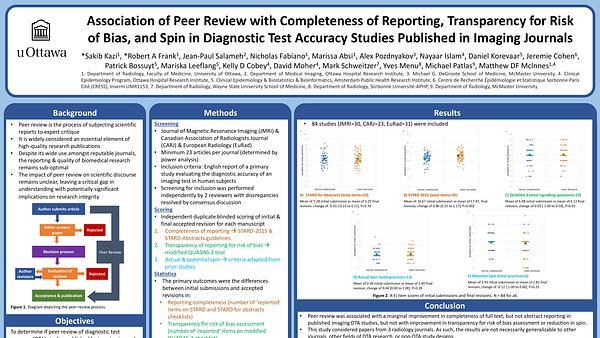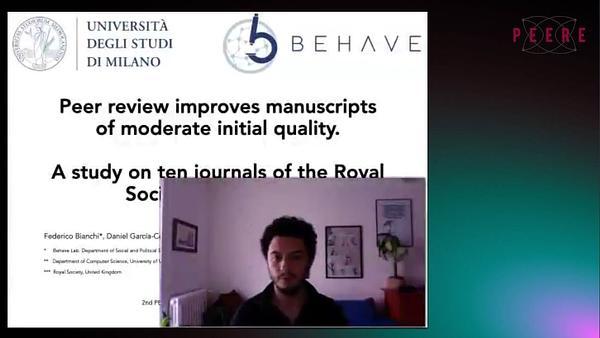Would you like to see your presentation here, made available to a global audience of researchers?
Add your own presentation or have us affordably record your next conference.
keywords:
funding/grant peer review
peer review process and models
peer review
Objective The Patient-Centered Outcomes Research
Institute’s (PCORI’s) review of research applications uniquely
includes patient and stakeholder reviewers alongside
scientists. PCORI switched to virtual panel discussions in
response to the COVID-19 pandemic. The few prior studies
examining virtual review for health research were mostly
small scale, provided mixed results, and did not consider
multistakeholder processes.1,2 This study examined how
virtual panels compared with in-person panels on reviewer
scores and experiences, whether differences between panels
varied by reviewer type (scientist, patient, or stakeholder),
and reviewer perceptions of challenges and benefits of virtual
panels.
Design This cross-sectional, mixed-methods study analyzed
data for PCORI funding opportunities before and after
switching to virtual review, including review score data (8
in-person cycles and 4 virtual, 2017-2021) and closed and
open-ended responses from anonymous online surveys of
reviewers (1 in-person cycle 2017 and 2 virtual 2020-
2021). Virtual vs in-person panels were compared on (1) final
overall review scores and changes in overall scores before and
after panel discussion for primary reviewers using linear
regression, which included examining the interaction of panel
type and reviewer type; and (2) reviewer perspectives on
giving and receiving input using logistic regression (5-point
Likert agreement scales dichotomized as agree vs neutral/
disagree). Regression models controlled for reviewer and
application characteristics. Sensitivity analyses included
multilevel models to account for hierarchy of reviewers and
scores. For virtual cycles, open-ended survey responses were
analyzed through inductive and deductive qualitative coding
to identify themes regarding reviewers’ perceived challenges
and benefits of virtual review.
Results The analytic sample included 2897 reviews (2253
in-person, 644 virtual) and 388 survey responses (191
in-person, 197 virtual; 75%-83% response rate). Final review
scores (mean SD score for in-person, 4.7 1.67; for virtual,
4.5 1.67) and absolute value of score changes (mean SD
score for in-person, 0.8 0.96; for virtual, 0.7 0.97) were
similar between virtual and in-person panels (P > .05 for all)
(Table 44); there were no significant associations for
interactions of panel type and reviewer type (P > .05). In
closed-ended survey items, most reviewers agreed that
reviewers of each type (patient or stakeholder and scientist)
were receptive to input from the other type (85%-96% across
reviewer types), and there were no differences in agreement
by panel type (P > .05 for all) (Table 44). In open-ended
survey responses, reviewers noted challenges of virtual
panels, including disruptions to discussion quality and flow,
missing social interactions among reviewers, and technical
and logistical issues; reviewers also noted benefits of virtual
panels, including convenience and lack of travel.

Conclusions Findings indicate that, despite some
challenges, virtual review panels were similar to in-person
panels on review scores and key aspects of reviewer
experiences in a multistakeholder process. Virtual panels
could be further considered as a viable approach for PCORI in
the future to offer flexibility in circumstances beyond the
COVID-19 pandemic.
References
1. Carpenter AS, Sullivan JH, Deshmukh A,Glisson, SR, Gallo
S. A retrospective analysis of the effect of discussion in
teleconference and face-to-face scientific peer-review panels.
BMJ Open. 2015;5:e009138. doi:10.1136/
bmjopen-2015-009138
2. Gallo SA, Carpenter AS, Glisson SR. Teleconference versus
face-to-face scientific peer review of grant application: effects
on review outcomes. PLoS ONE. 2013;8(8):e71693.
doi:10.1371/journal.pone.0071693
Conflict of Interest Disclosures None reported.
Funding/Support PCORI provided funding for this work.
Role of the Funder/Sponsor PCORI staff planned and
conducted all of the following aspects of this work: design and
conduct of the study; collection, management, analysis, and
interpretation of the data; preparation, review, or approval of the
abstract; and decision to submit the abstract for presentation.
Acknowledgments PCORI thanks everyone who has served as
a Merit Reviewer for their time and invaluable input on research
applications. The authors also thank Cary Scheiderer and Layla
Lavasani (former PCORI staff) for sharing their insights about key
elements of the review process and Sarah Cohen and Heidi Reichert
of EpidStrategies for their consultation on statistical methods used
in this abstract.


